It is our privilege to introduce to the auction market an Important Private Collection of Canadian Art, a selection of rare and remarkable historical artwork, most of which is making its auction debut with Cowley Abbott this fall, part of a two-session live auction event. December will mark the first of three seasons of offerings from this collection.
Accessible Art in August!
The August online auctions are full of great opportunities for the emerging art collector. Historical and contemporary paintings, photographs, drawings, sculptures and a variety of prints are divided among four sessions.
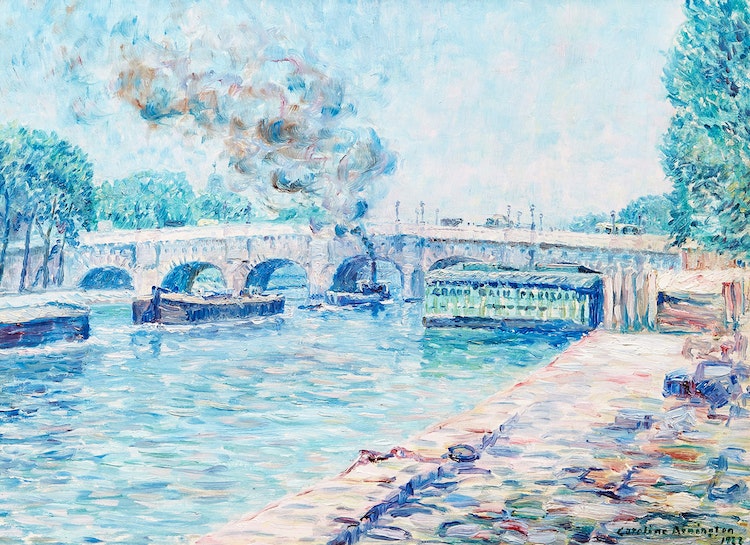
Le Pont Neuf, Paris
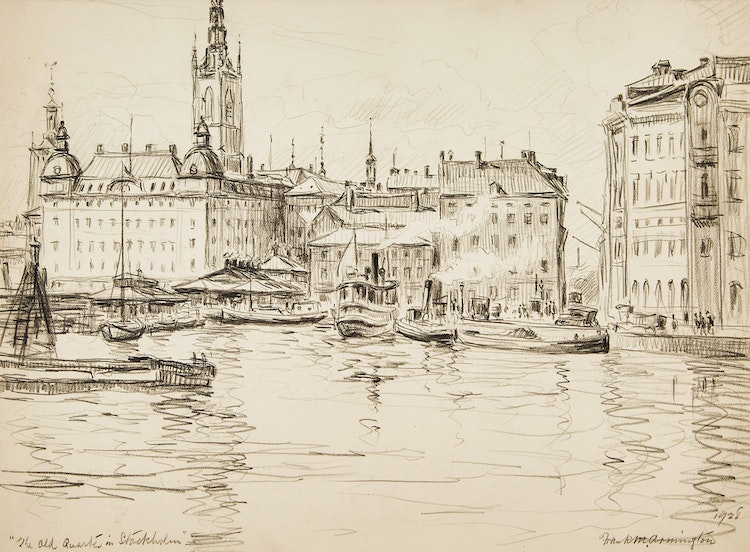
The Old Quarter in Stockholm
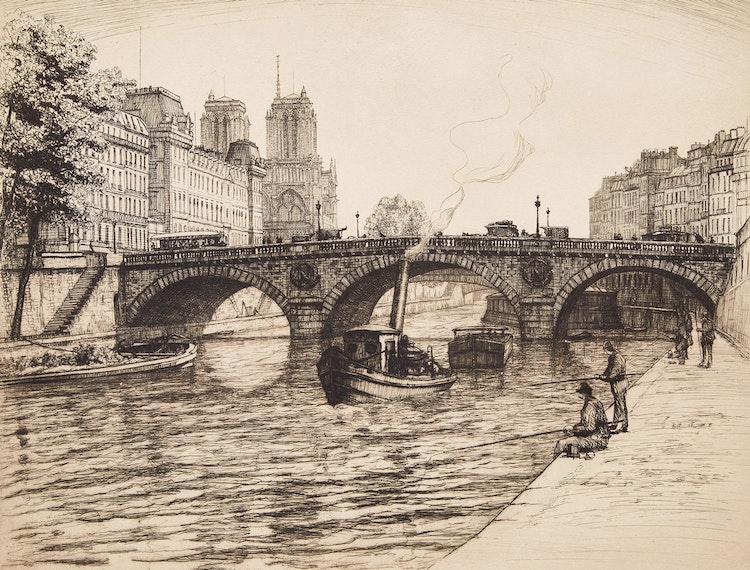
Le Pont Saint Michel à Paris
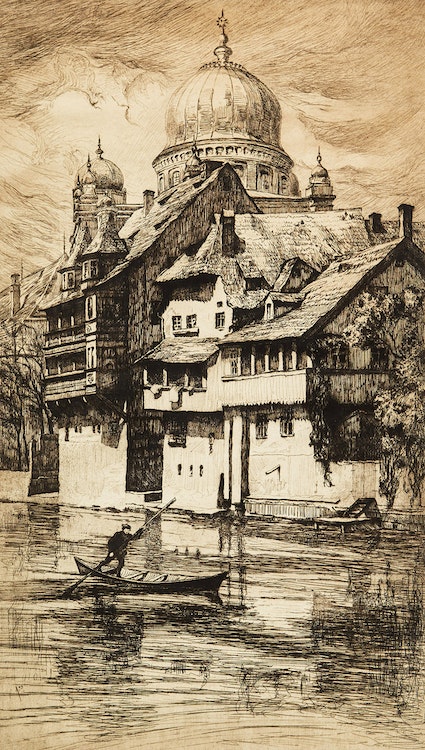
Alte Hanser an der Pegnitz, Nuremberg
The first session, Canadians at Home & Abroad includes the work of the Canadian artist couple Frank and Caroline Armington. The couple met in Ontario but spent over thirty years living together in Paris and travelling throughout Europe. A number of pieces documenting their life abroad are featured in the auction, such as Frank Armington’s The Old Quarter in Stockholm (lot 17) and Halte Hanser an der Pegnitz, Nuremberg (lot 18), and Caroline Armington’s two depictions of Parisian Bridges: Le Pont Saint-Michel à Paris (lot 19) and Le Pont Neuf, Paris (lot 20).
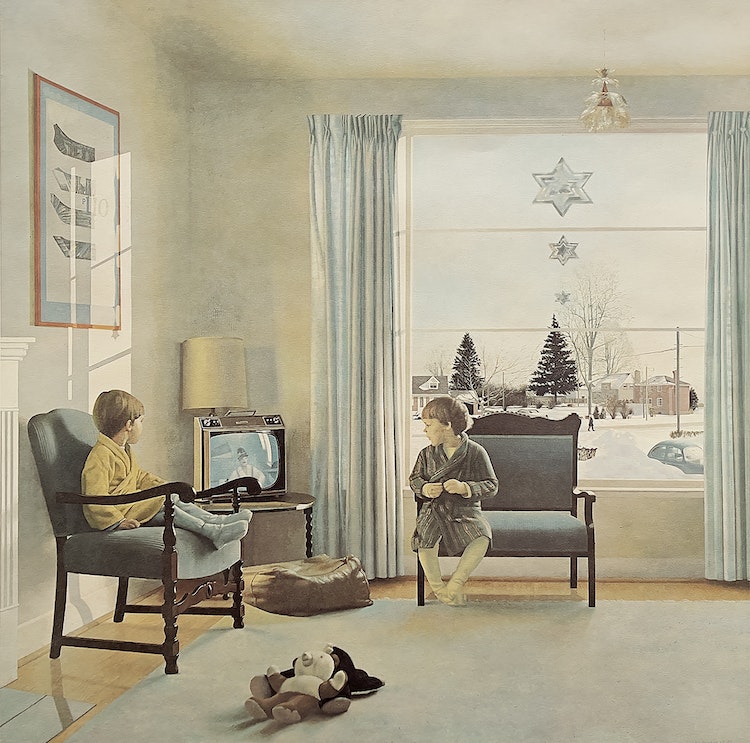
Sunday Morning No. 2

Guards
In the Prints & Works on Paper session, lot 104 is a timeless tranquil interior scene by Jack Chambers, executed in a photo-realist lithograph print. A large and nicely framed image entitled Guards, by contemporary photographer Laurent Guérin is a great find for a modern space, and appeals especially to dog-loving art collectors.
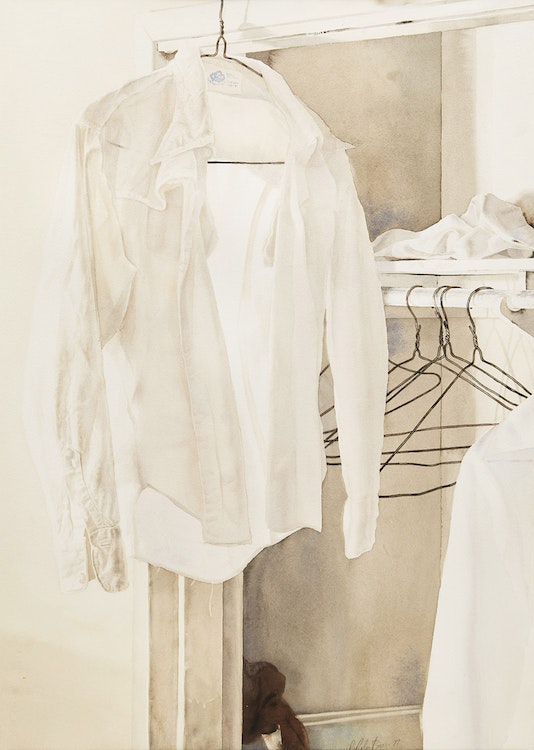
Hanging Shirt
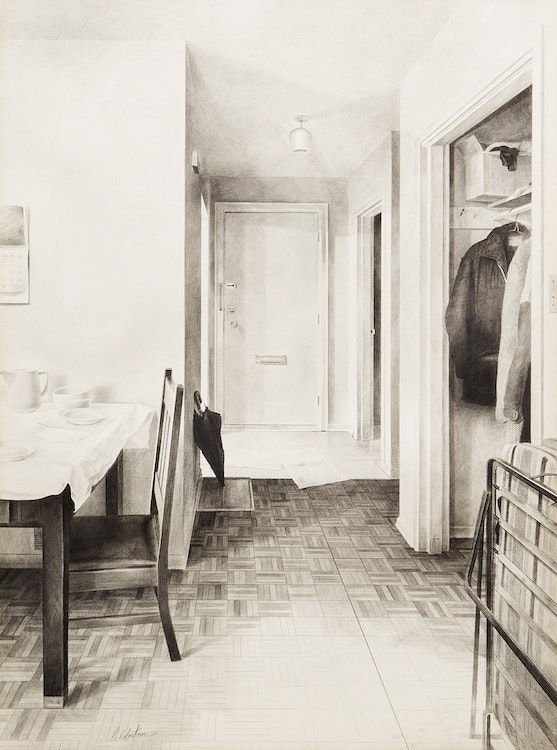
Hallway

Silent Echo II
Two delicate pencil drawings by Richard Robertson, lots 122 and 123, are a calming duo to hang up in a home. Lot 129 is one of L.L. Fitzgerald’s famous negative image architectural linocuts, which dates to 1938 but has a timeless feel. For a bold abstract option, Rita Letendre’s Silent Echo II has a strong energy and cool retro colour palette of brown and black.

Seated Nude
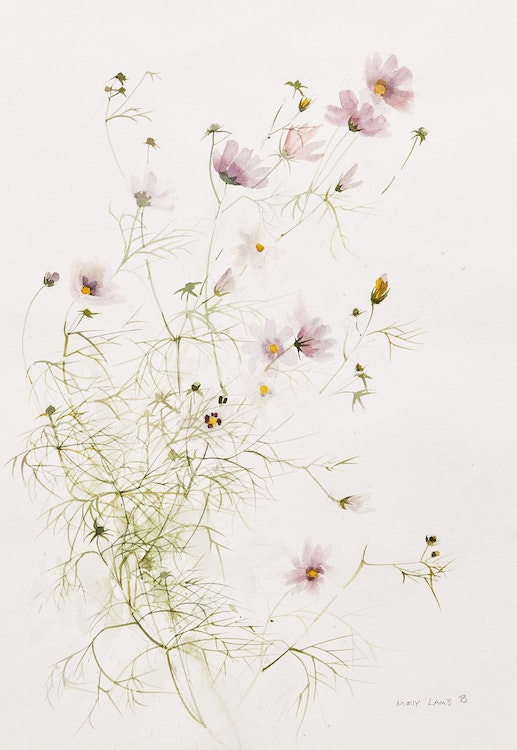
Cosmos
In the Still Life and Figural Work session, lot 193, Seated Nude by Hugh Mackenzie, is a fine ink drawing with an eye-catching circular format. It is another example of a timeless image, despite it being dated 1968 by the artist. The renowned and talented Molly Lamb Bobak, who is known for her floral watercolour paintings, depicts cosmos so delicately that they appear to be floating (lot 203, Cosmos).
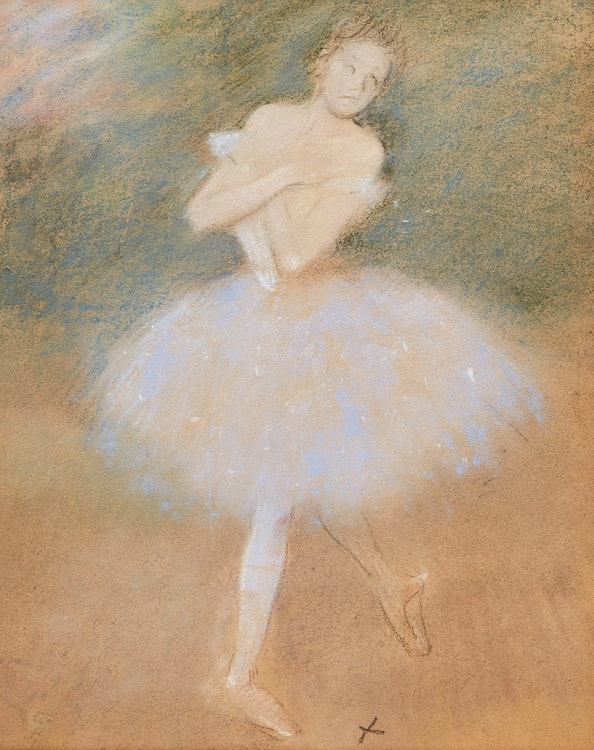
The Dancer
French impressionist and protegé of Edgar Degas, painter Jean-Louis Forain’s Dancer in soft pastels is a lovely work and great opportunity, estimated at $600-800.

Birthday Love Songs
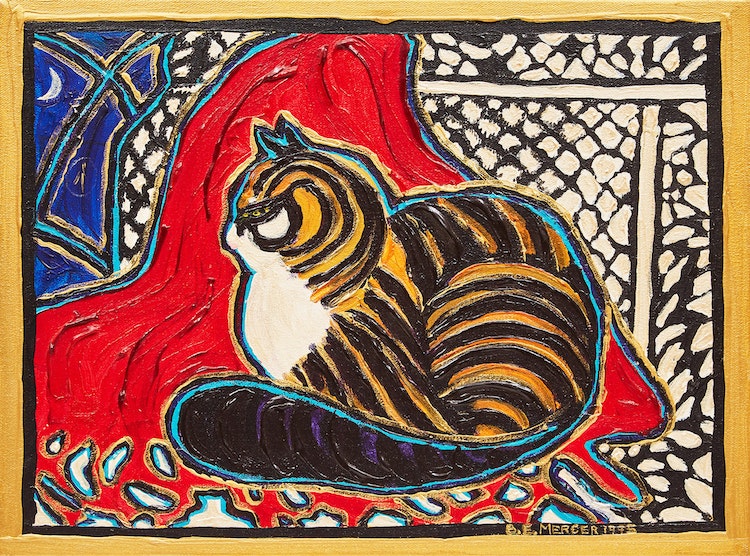
Cat Dreams No.1
The final session, The Estate of Barbara Mercer, offers some colourful and whimsical works such as lot 263 Birthday Love Songs and lot 268 Cat. There is truly something for everyone in this month’s auction, and at very accessible price points. We invite you to browse through the full catalogue of 276 works and do not hesitate to contact us if you have any questions, at [email protected]. The auctions close on August 23.
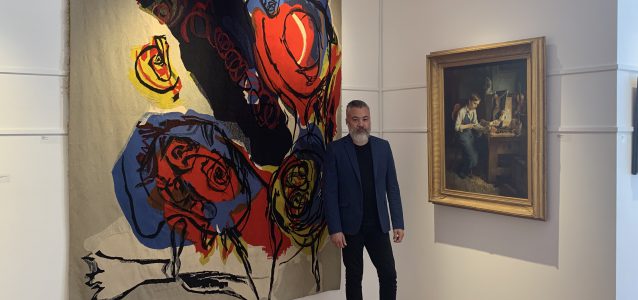
Perry, our International Art specialist, highlights a selection of outstanding artworks included in the current Spring Auction of International Art. Take a moment to learn about these fantastic artworks. Bidding closes on June 28th!
The Young Craftsman
Painted the year the artist died, “The Young Craftsmen” echoes one of Rosenthal’s best known paintings, “His Madonna”, which was painted the previous year. The similarities seem endless from the likeness of the young boy working in his white shirt with a red handkerchief stuffed into his blue apron to his wooden workbench with his carving tools splayed in front of him and wood shavings littering the floor. However, where “His Madonna” positions the viewer at a more distanced vantage point, “The Young Craftsmen” creates a more intimate portrait of the young subject by bringing the viewer in closer to the scene. The boy’s face is turned slightly toward the viewer which invites us into a more personal connection to the sitter.
“The spectacle of the sky overwhelms me. I’m overwhelmed when I see, in an immense sky, the crescent of the moon, or the sun. There, in my pictures, tiny forms in huge empty spaces. Empty spaces, empty horizons, empty plains – everything which is bare has always greatly impressed me.” -Joan Miró
Two Abstract Sculptures
Vincenzo Amato was born in Palermo, Italy in 1966; he is primarily known as an actor appearing in numerous films and tv shows. Early in his artistic career he had a couple of exhibitions at gallery Il Gabbiano in Rome. In the early 1990s he arrived in New York for a wedding and never left, continuing to pursue a career as an actor and sculptor, exhibiting his work at the Earl MacGrath Gallery.
Figura
In 1935 Kingman submitted a controversial work to Ecuador’s esteemed Mariano Aguilera Prize. It caused outcry among the conservative jury and was rejected from the competition. However, the following year Kingman’s peers championed him and the same work won first prize in the same competition. The moment lead to Indigenism being adopted as the dominant artistic style in Ecuador. In the 1930s Kingman painted indigenous workers in a monumental style that emphasized their human suffering. After World War II, he expanded his themes to include all human deprivation to capture the universal humanity of his subjects.“Figura” depicts a lone woman, with her head resting in her hands. The artist forms a triangular composition that leads the eye upwards towards the subject’s half obscured face. The oversized cupped hands magnify her despair with every etched line. The worn, crimson knuckles emphasize her suffering. Kingman was known for his exaggerated, expressive style, which we see here in this lovely example of his work.
Woman and Man Bench
A wonderful bench by John Risley, an American designer and craftsman. Risley studied at the Rhode Island School of Design and the Cranbook Academy of Art in Michigan, before moving to the Philippines and later to Taiwan to work for the state department, absorbing influences from those cultures in his work. Risley produced these benches as a series, some executed in red and some in black. The idea was to make these art objects both functional and decorative.
Maternal Embrace
A member of the ancient house of Troubetzkoy by birth, Prince Paolo (Paul) Troubetzky was the son of a Russian diplomat and American singer Ada Winans. Largely self-taught he did come under the influence of Guiseppe Grandi, an avant-garde sculptor who was associated with the Scapigliatura movement. Troubetzkoy was a passionate animal activist and vegetarian, keeping a menagerie of animals in his studio, which became the subjects of some of his sculptures. He moved in the gilded age circles of the day, sculpting portraits of the rich and famous. In “Maternal Embrace”, the subtle play of light across the deep modeling of the figures as they emerge from the folds of the dress, captures a tender moment between a mother and her child. The plaster for this work dates from 1898 and is housed in the collection of the Museo Del Paesaggio, Verbania.
The Spring Auction of International Art closes for bidding on Tuesday, June 28th. Find more information about the artworks included in the auction here: https://cowleyabbott.ca/items/1178 and contact our Perry for more information at [email protected].
From The Estate of Robert Markle Online Auction – June 14th to 28th

In conjunction with our current dedicated auction of works from the Estate of Robert Markle, this week’s blog entry is dedicated to the life and work of artist, Robert Markle. Contemporaries with Graham Coughtry, Gordon Rayner, Dennis Burton, and Harold Klunder, Markle broke boundaries in contemporary art practices and questioned the definitions of high and low art subject matter when it came to the body and sexuality within his practice. He was a multi-disciplinary artist, practicing in painting, printmaking, writing, music and collaborated with his peers regularly. In addition, he also held teaching positions at The New School of Art, Art’s Sake Inc. and the University of Guelph.
Born in 1936 in Hamilton, Ontario, Markle is of Mohawk ancestry, but struggled with his identity while growing up. He states that “people should be aware [that] you can be a Native Canadian and still understand [that] Christopher Wren is wonderful and Rembrandt is wonderful and Western art is wonderful.” Some of the artist’s later works incorporate cultural themes and symbols in his work.
Robert began studying at the Ontario College of Art in Toronto in 1954 but was later expelled before graduating for throwing a bottle of acid against a wall. Before leaving, however, Robert met Marlene Shuster, a fellow student, and the pair later married in 1958. Marlene was not only Robert’s steadfast life partner, but was also his primary model and muse with her likeness captured in many of the artist’s figural works. In addition to Marlene, Robert frequented burlesque clubs to source inspiration of the form.
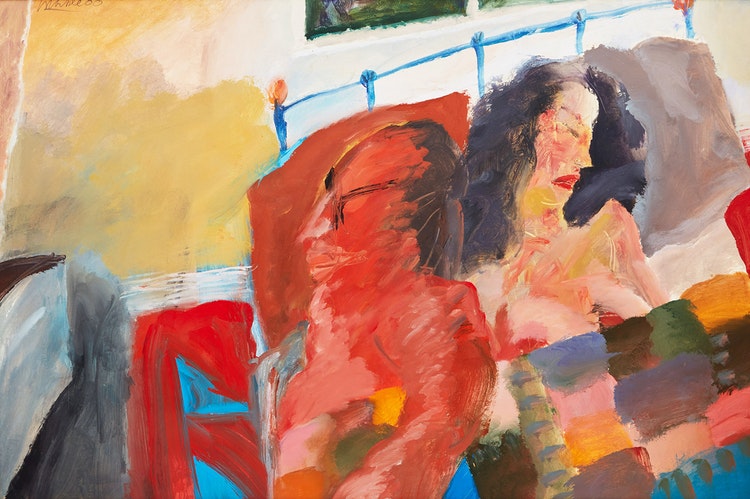
Robert Markle’s first one-man exhibition was held in 1963 at the Isaacs Gallery in Toronto, where Marlene had also worked. Markle was eventually associated with the so-called “Isaacs Group” of artists, who were known for both their avant-garde artwork and their drinking. Some of these artists, including Markle, were part of the Artists Jazz Band, which was formed around 1962. His exploration in music greatly influenced his work with both smooth lyrical and abrupt staccato movements present in his works. Long fluid single strokes of pigment can define the body while aggressive short strokes and spontaneous drips of paint punctuate the picture plane and create a complex visual statement in the artist’s works.

Many of Markle’s figural works often lack clear identifiable faces to focus on the form of the figure. In many of the works, not only is abstraction integrated into his practice, but also the landscape. Horizontal works of reclining and outstretched figures recall layered landscapes as the eye travels across the curves and angles of the body. He has been quoted as stating: “Every artist needs a central issue. My nudes are like Tom Thomson’s jack pine.”
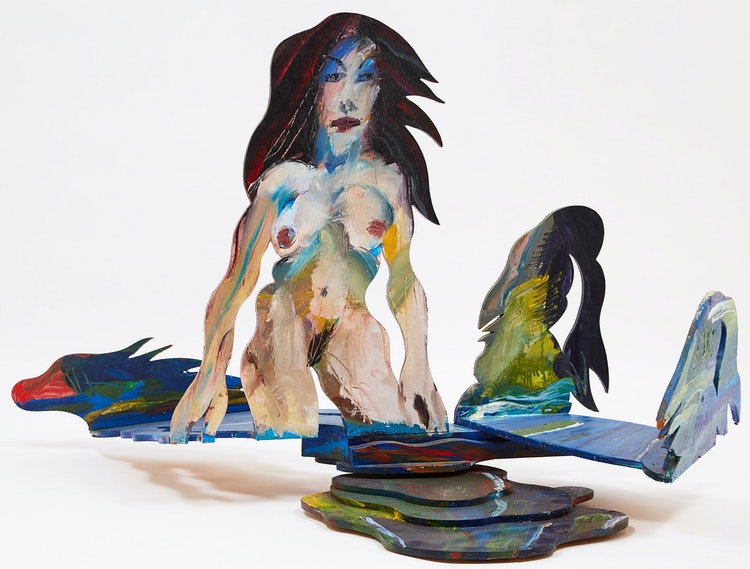
During his career, Markle primarily produced tempera and acrylic paintings as well as ink drawings, although he did also explore other mediums including printmaking under the guidance of close friend and master printmaker, Otis Tamasauskas. Markle also collected folk art which helped inspire his later kinetic ‘whirligig’ artworks which incorporated his signature nude motifs and technicolour colour palettes.

Infamously, Markle’s participation in a group show called “Eros ’65” at the Dorothy Cameron Gallery in Toronto has been rife with controversy. A police raid led to an obscenity trial that Robert Fulford called “a comedy of mutual incomprehension.” Cameron was charged with exposing “obscene pictures to public view” and the gallery closed shortly thereafter which helped make Markle famous for his provocative works. The controversy sparked a national debate about censorship and the distinction between erotic art and pornography and placed Markle’s work at the centre of the conversation.
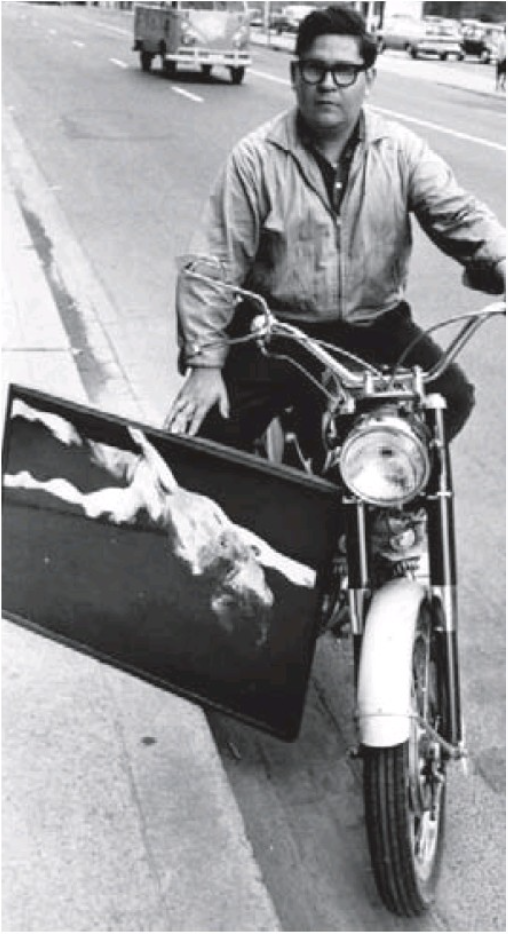
Over a decade after Markle’s untimely death in 1990, Tony Massett organized a retrospective at the Durham Art Gallery (December 2002 to January 2003), and one year later, curator and art historian Anna Hudson organized an exhibition entitled “Woman as Goddess: Liberated Nudes by Robert Markle and Joyce Wieland” displayed at the Art Gallery of Ontario (November 2003 until February 2004). In August 2011, “Blazing Figures: A Retrospective of Robert Markle” opened at the Gallery de Boer in Owen Sound. A pivotal work by the artist, entitled “Mohawk: Meeting”, a neon, stainless steel and acrylic painting measuring 15’ x 160’ is installed in the Metro Toronto Convention Centre.
The collection of works direct from the estate of the artist help paint a picture of Markle as an artist, friend, partner and collector. Many works from his peers had been gifted, traded and collaborated on and are testament to his larger than life personality. Important works by Willem de Kooning, Gordon Rayner, and Graham Coughtry pepper the auction and create a harmonious dialogue with Markle’s own work. The collection of works highlight the significance of his career (1960s–1990) in Canadian art, as well as that of the Isaacs group and the Toronto art scene.
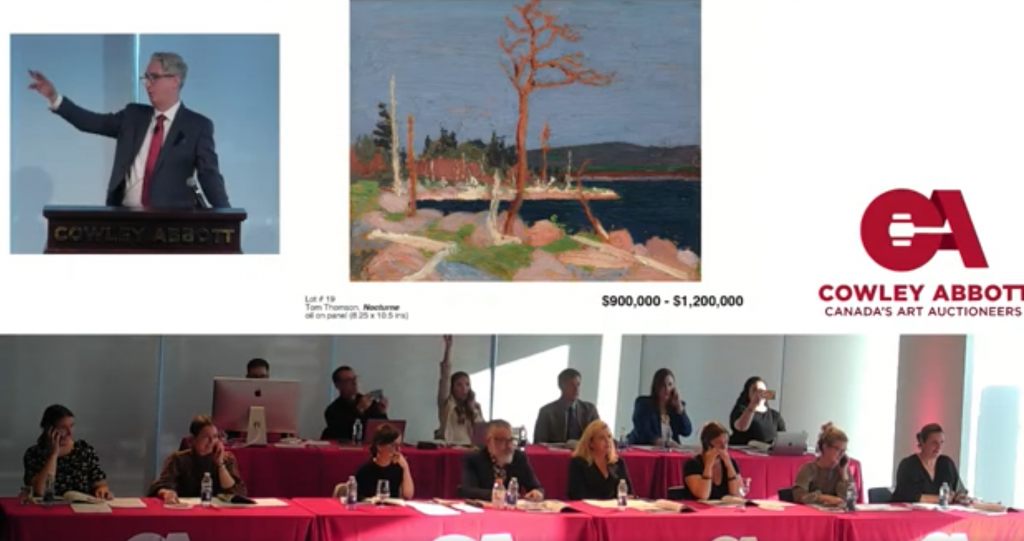
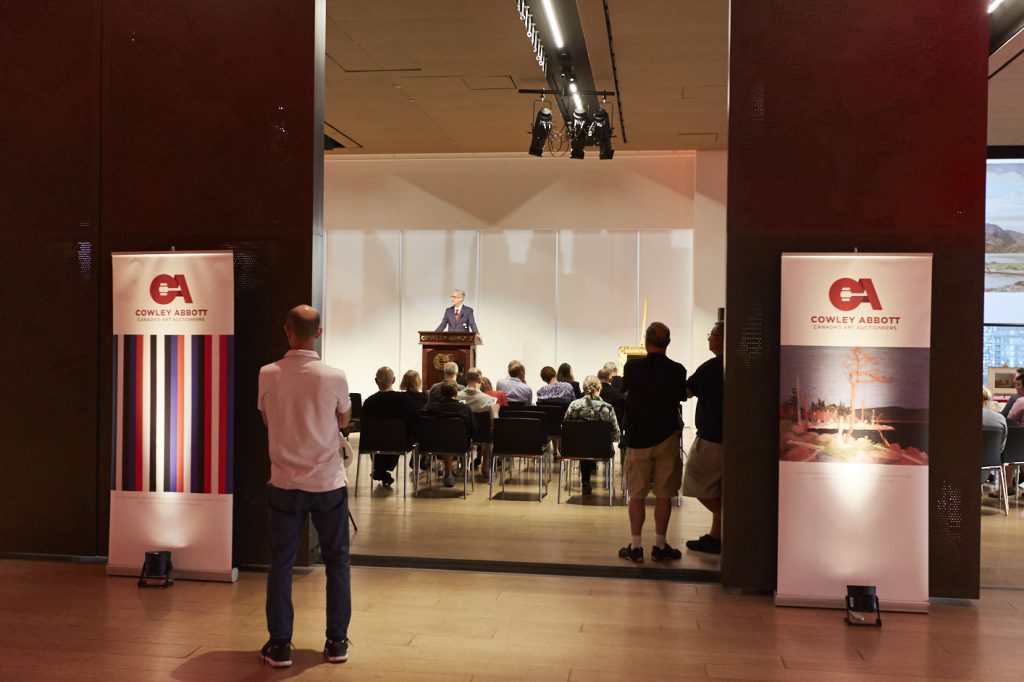
Cowley Abbott’s Spring Live Auction of Important Canadian Art on June 15th presented a catalogue of important and rare artworks by some of Canada’s most celebrated artists. Hosted at a new venue, the Globe & Mail Centre, which boasts a terrific view of Toronto’s waterfront, clients enjoyed a chance to reunite in-person while enjoying a fast-paced auction with our experienced auctioneer, Rob Cowley, at the helm.

The evening auction drew collectors from across the globe to the hybrid model live auction, which took place simultaneously in-person in Toronto and online at CowleyAbbott.ca. With a room full of collectors and art lovers, Cowley Abbott experienced another season of exceptionally strong results.

An important painting by Tom Thomson exceeded expectations at Cowley Abbott’s Spring Live Auction of Important Canadian Art on June 15, 2022, selling for $1.5 million. Tom Thomson is one of Canada’s most recognized artists, not only for his enduring legacy as a lover of the Canadian north, but for the tragedy of a talented life cut short. Nocturne, an evocative sketch, dates from Thomson’s golden painting year of 1916. This work has a long and distinguished pedigree. Initially purchased by W.J. Alexander, the first professor of English at the University of Toronto, and later owned by Keith MacIver, a former prospector, who – after Thomson died – lived in Thomson’s “Shack” situated next to the Studio Building in Toronto. Private collections have kept this work well-hidden from public view since 2000, until offered by Cowley Abbott. Appearing for the first time at auction, Nocturne drew heated bidding from enthusiastic collectors attending in-person, online and by phone, well surpassing the auction estimate of $900,000 – $1.2 million.
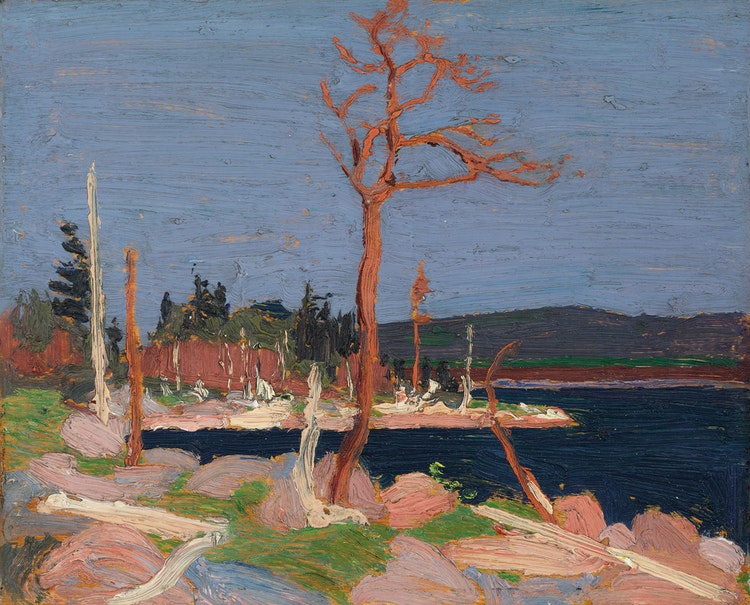
Price Realized: $1,500,000
A monumental canvas by Anishinaabe artist Norval Morrisseau sets a new artist record selling for $312,000, quadrupling the previous record. Animal Unity smashed the current artist record at auction soaring to $312,000, more than four times the low end pre-sale estimate and over four times the previous record of $71,500, set over a decade ago. Morrisseau is considered to be the grandfather of contemporary Indigenous art in Canada. His work is instantly recognizable and Animal Unity, with heavy black and red outlines and colourful composition, reflects the artist’s early figurative imagery, depicting the interdependence of all creatures on land, in the sky and from the sea.
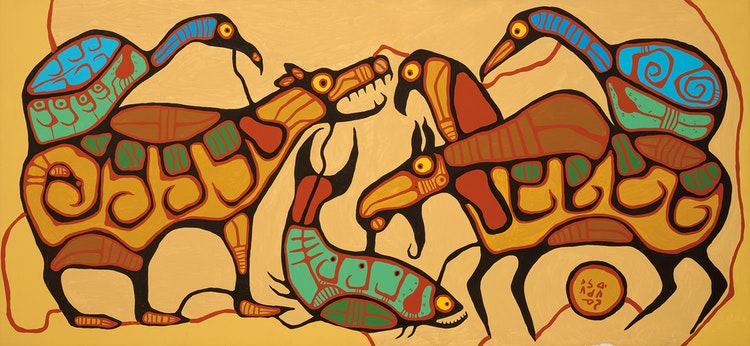
Price Realized: $312,000

Série noir/blanc, a museum quality canvas and an unparalleled Stripe painting by revered Quebec artist, Guido Molinari, raced to $264,000 on the phone. This painting was presented on the back cover of the auction catalogue and is a “stop-you-in-your-tracks” stunner of a work that thrilled every visitor to the Cowley Abbott gallery during the six weeks of previewing ahead of the auction.

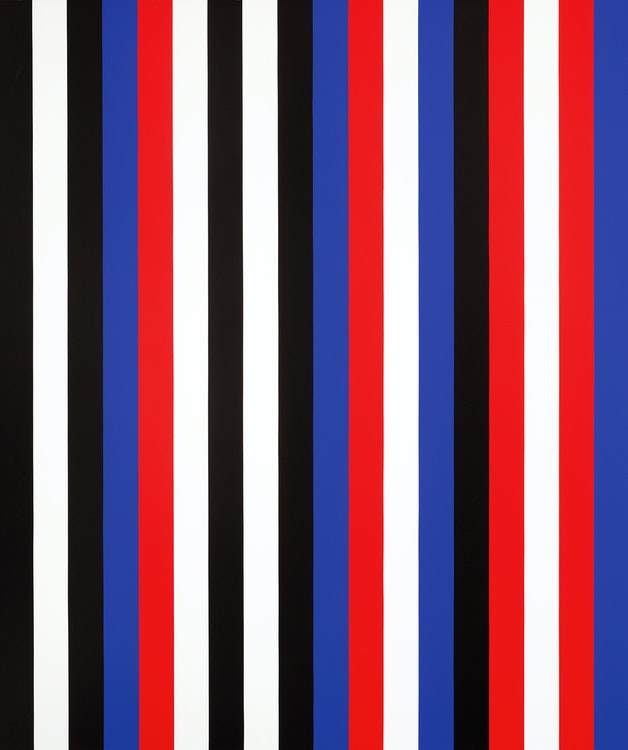
Price Realized: $264,000
Fierce bidding took place on the phones, online and in the room for three works by the beloved east coast painter Maud Lewis: Three Black Cats fetched $84,000, Winter Sleighride sold for $52,800 and Car Ride Through Town, a favourite during previews, reached $90,000.

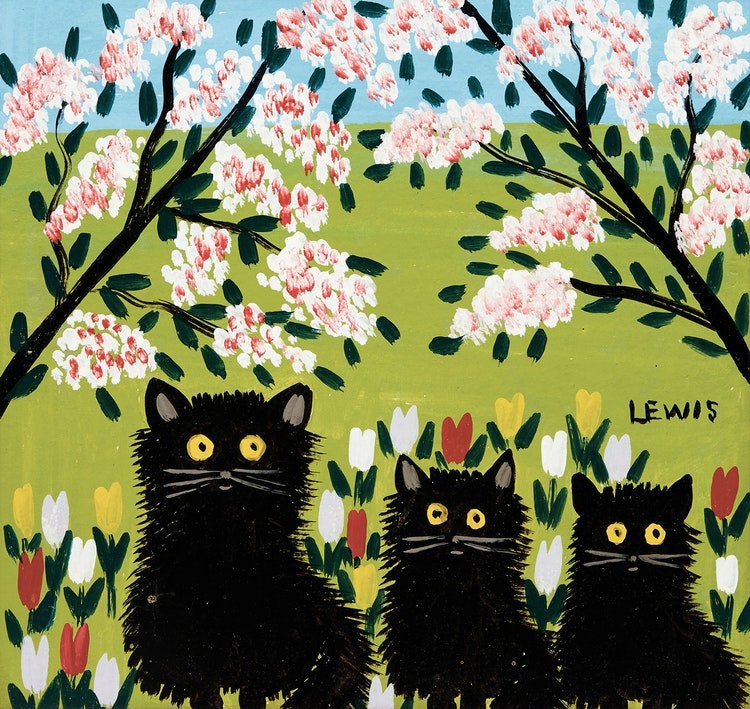
Price Realized: $84,000
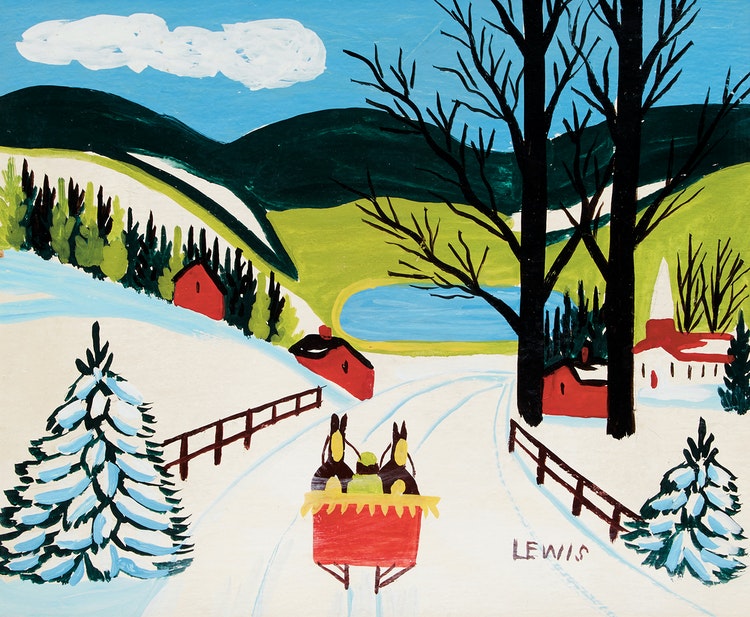
Price Realized: $52,800

Price Realized: $90,000
Backyards, a work by celebrated Canadian female painter Isabel McLaughlin, attracted ample pre-sale interest and sold for $40,800, doubling the estimate. McLaughlin herself knew the value of this painting as the opening salvo of her contribution to Canadian art. As one of her most important paintings, she presented it in every exhibition she could.
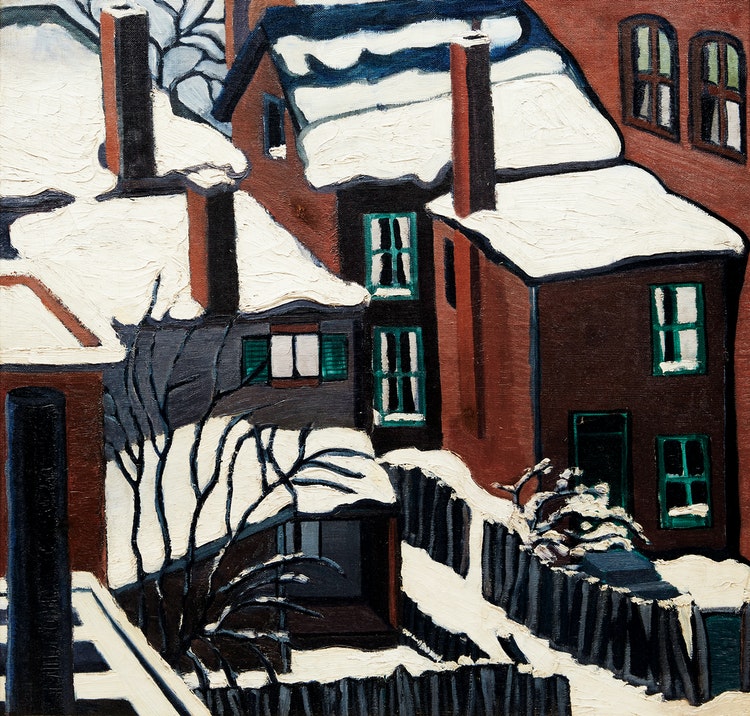
Price Realized: $40,800
The Group of Seven showed continued market strength: paintings by A.J. Casson sold for $120,000 and $144,000, a mid-century A.Y. Jackson canvas depicting Quebec fetched $96,000 and a fresh to market work by Franklin Carmichael, Study of Trees, Autumn, found a new home at $60,000.
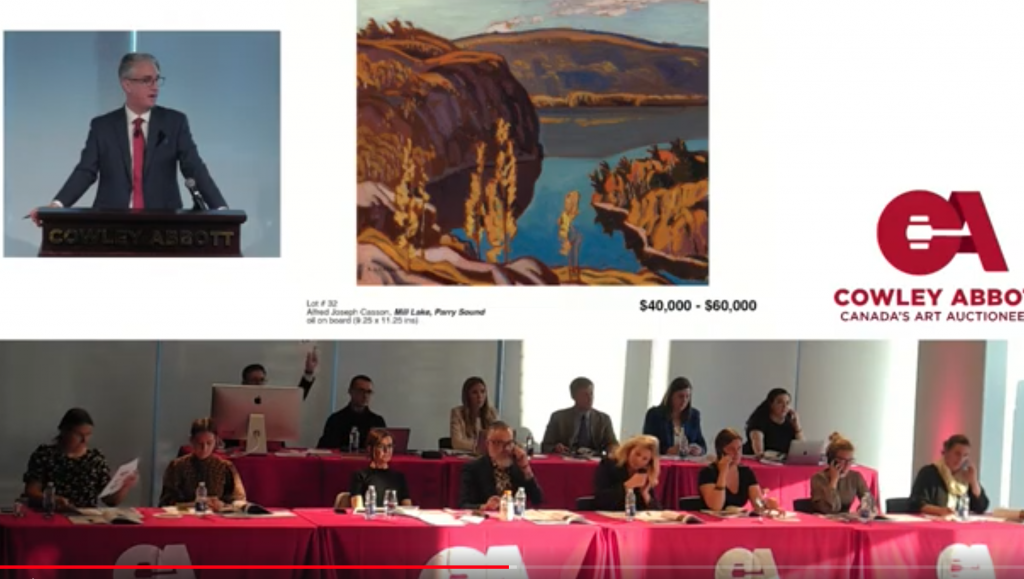
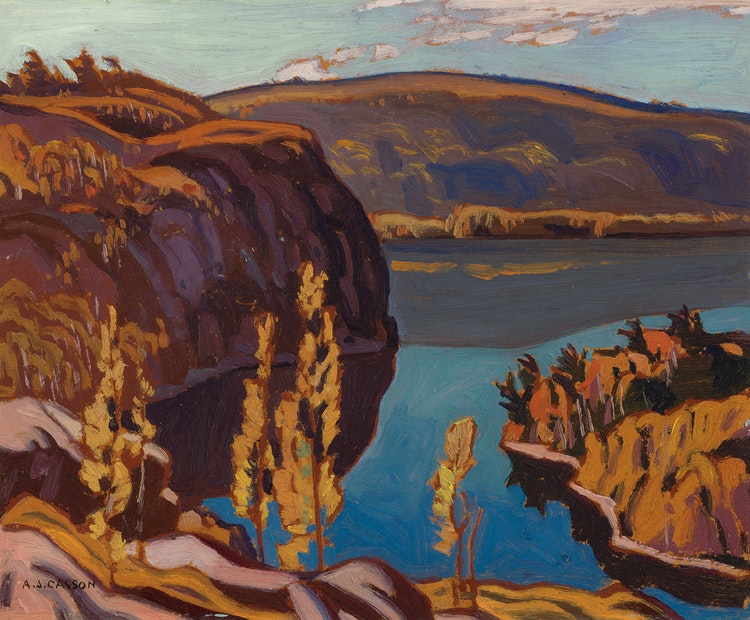
Price Realized: $144,000
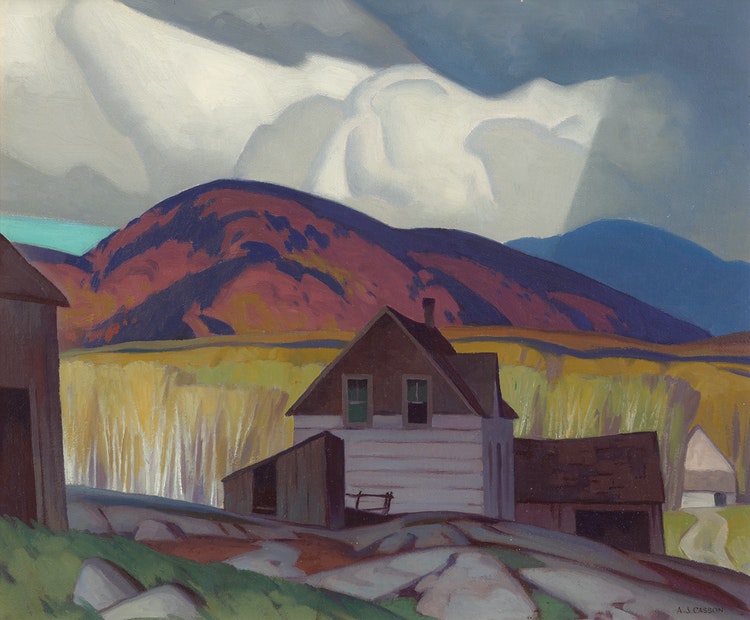
Price Realized: $120,000
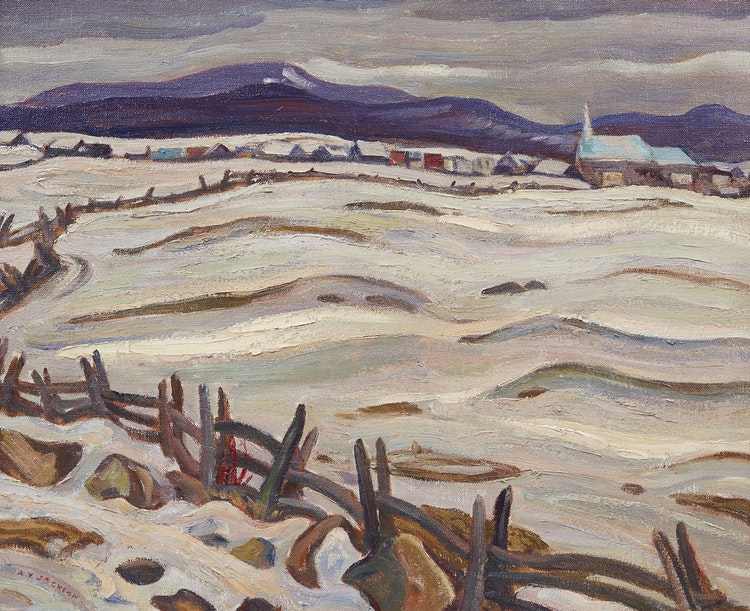
Price Realized: $96,000
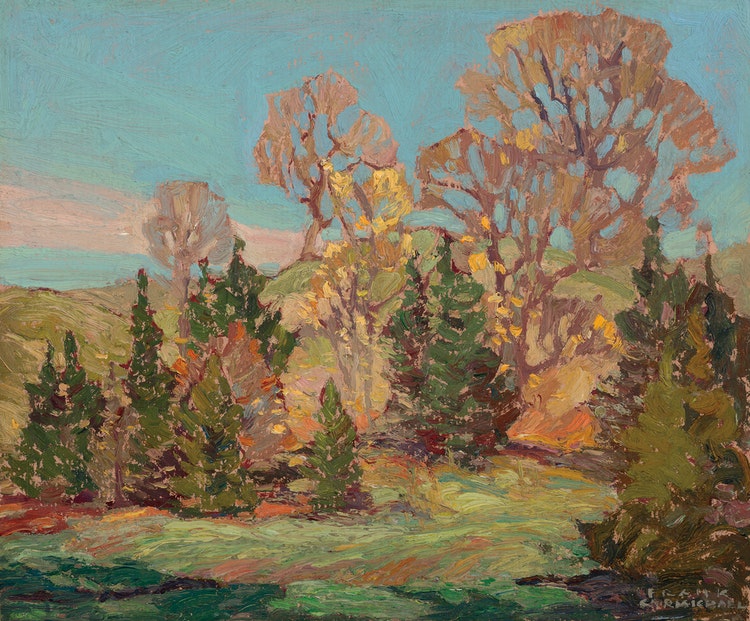
Price Realized: $60,000
A rare genre scene by the 19th century Canadian artist, Cornelius Krieghoff, French Canadian Habitants Playing at Cards, saw fierce bidding, selling for $144,000. Recognized as a treasure within the artist’s oeuvre, the rarity of a canvas with such an abundance of figures, exquisitely rendered detail and narrative strength is a prize for any astute collector of historical Canadian art.
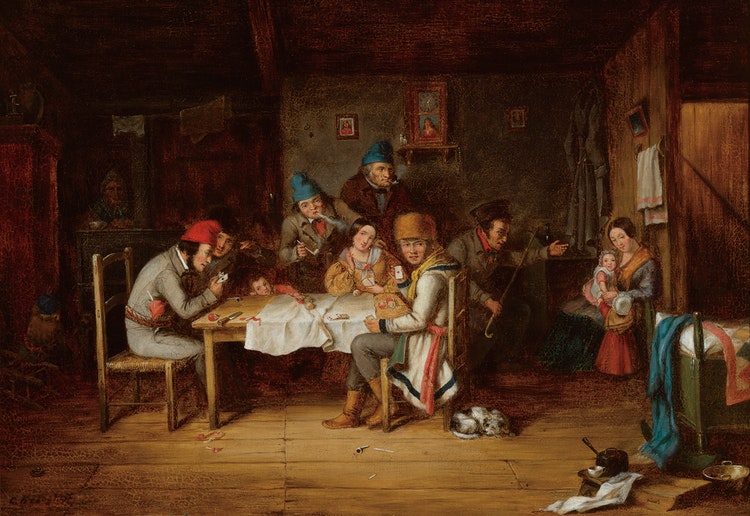
Price Realized: $144,000
Historical Canadian art showed continued strength with a fantastic record setting result for Charles Jones Way. Niagara Falls, the artist’s monumental depiction of the natural wonder soared to $24,000 in the evening auction. Another auction record set was for Arthur Heming’s dramatic canvas, Nearing a Fur Post, which sold for $48,000.
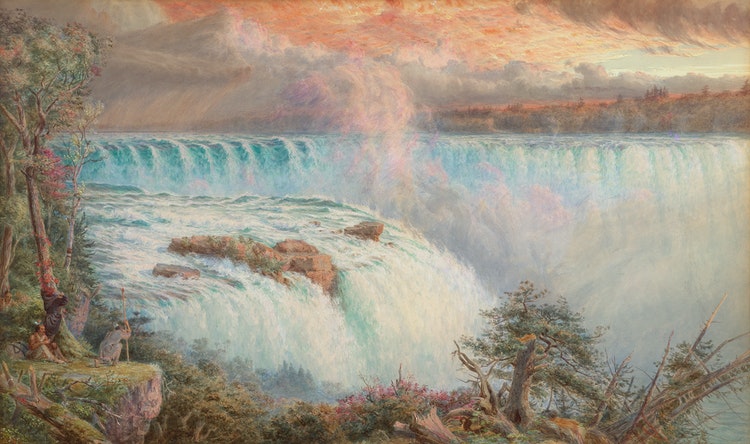
Price Realized: $24,000 (Auction Record)
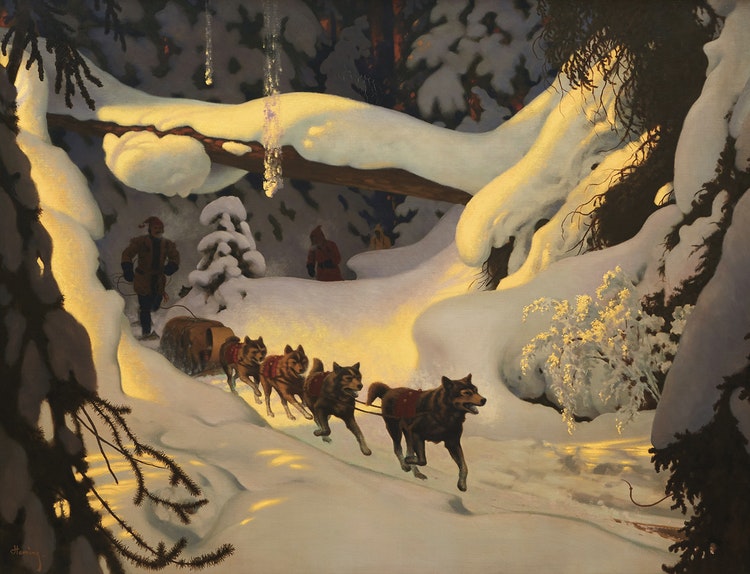
Price Realized: $48,000
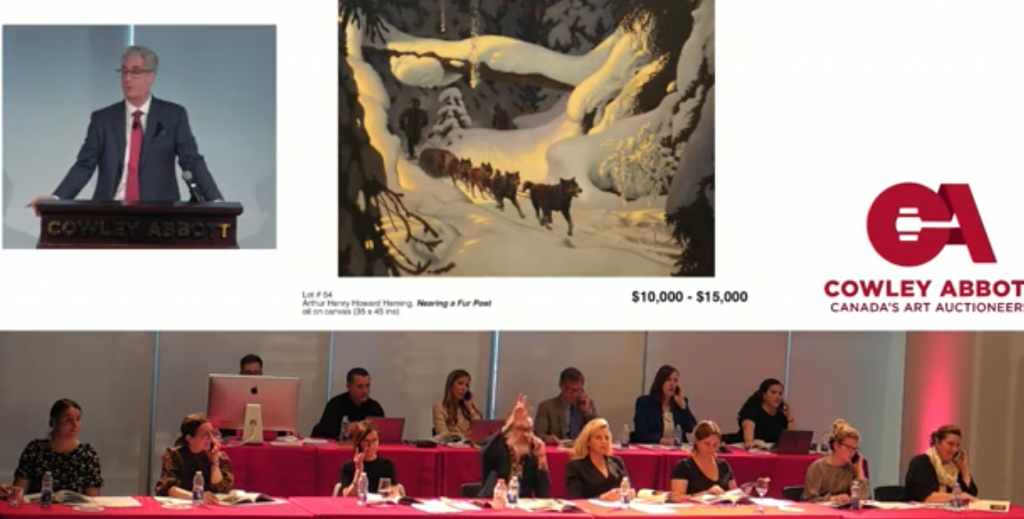
A prominent member of the Automatistes and a signatory of the Refus Global, Jean Paul Riopelle was a lifelong avant-garde and experimental artist. Riopelle’s works are both expressive and formal. Polyvalencia of 1961, signifying a new direction for the artist, also dates from an important period in Riopelle’s personal life, when he had begun a romantic relationship with American abstract painter Joan Mitchell. This dynamic oil fetched $120,000.
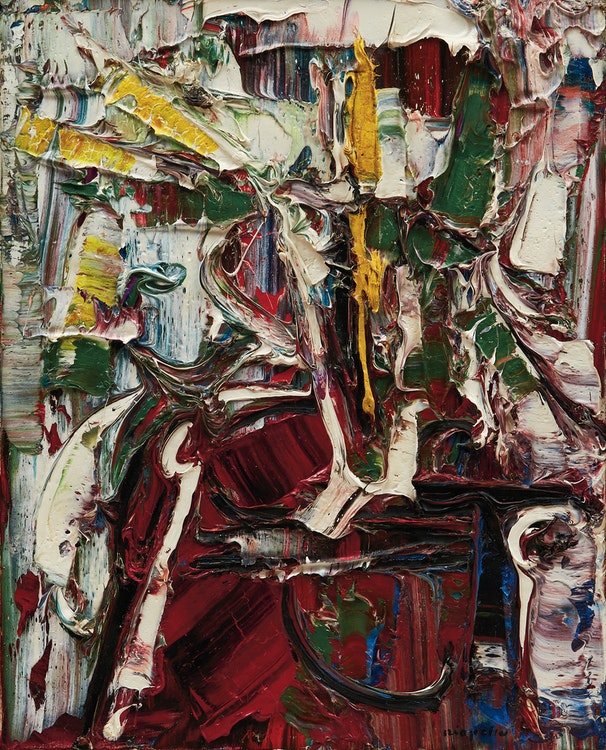
Price Realized: $120,000
A forerunner of abstract art in Canada, the self-trained Bertram Brooker was a skilled draftsman, talented advertising artist and businessman. Still Life (Variation No. 3) was one of two still-life paintings by Brooker included in the 1938 CNE exhibition in the “Canadian Small Pictures” section. Brooker’s Variation No. 3 appears to be an abstract version of the second painting, which depicted an arrangement of cabbage and peppers on white paper, a white tablecloth and a brown paper bag. This important work by Brooker sold for $24,000.
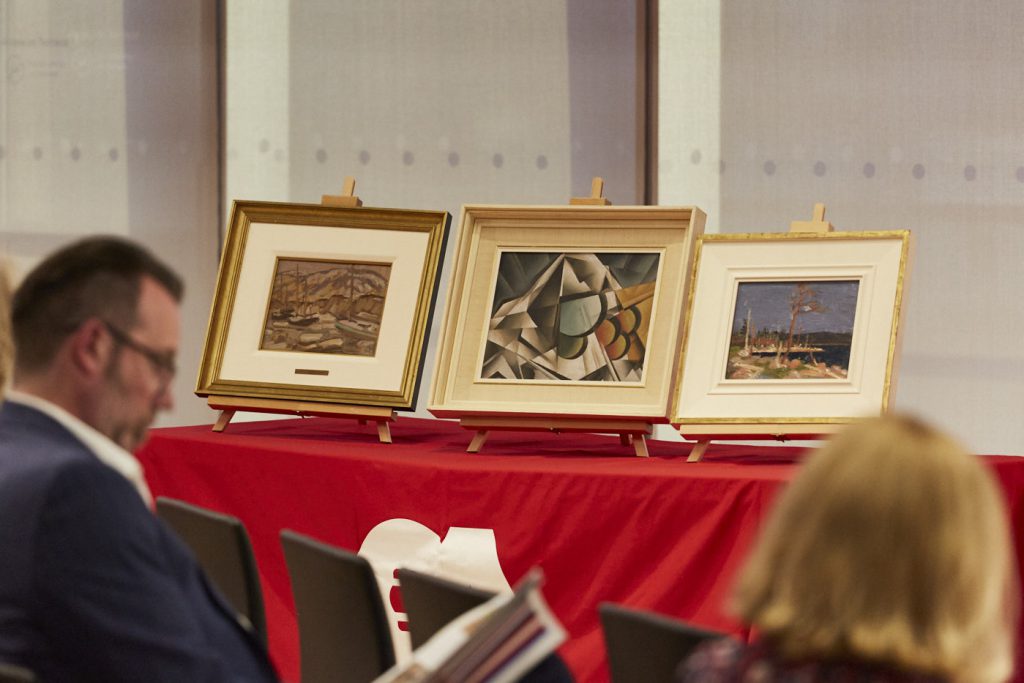

Price Realized: $24,000
As Canadian art increases in importance nationally, becomes more well-known internationally and the trends of art collecting expand, specific Canadian artists continue to be celebrated and sought after by new and seasoned collectors alike. It is proven that with high-quality online presentation and confidence in auction house specialists, collectors are eager to buy remotely and to find artworks of rarity and quality.


Cowley Abbott is grateful to all of the clients, bidders and art collectors who participated this auction season. We look forward to connecting further and sharing exciting upcoming projects with the Canadian art community. Stayed tuned for our upcoming themed online auctions and the next Live Auction of Important Canadian Art taking place in the fall.
“Nocturne”, an evocative sketch, dates from Tom Thomson’s golden painting year of 1916. Estimated at $900,000-1,200,000, this work has a long and distinguished pedigree. Private collections have kept this work well-hidden from public view since 2000, until today.
It has been a pleasure for Cowley Abbott to handle this painting and we look forward to offering this Tom Thomson tomorrow evening in our live auction.

Spring Live Auction of Important Canadian Art
June 15th
Rob and Peter both discuss the importance of this 1916 painting by Thomson in our new video, highlighting that the work was executed in the same year as Thomson’s “The West Wind” in the collection of the AGO.
View further images and information about this important painting here: https://cowleyabbott.ca/artwork/AW40914.
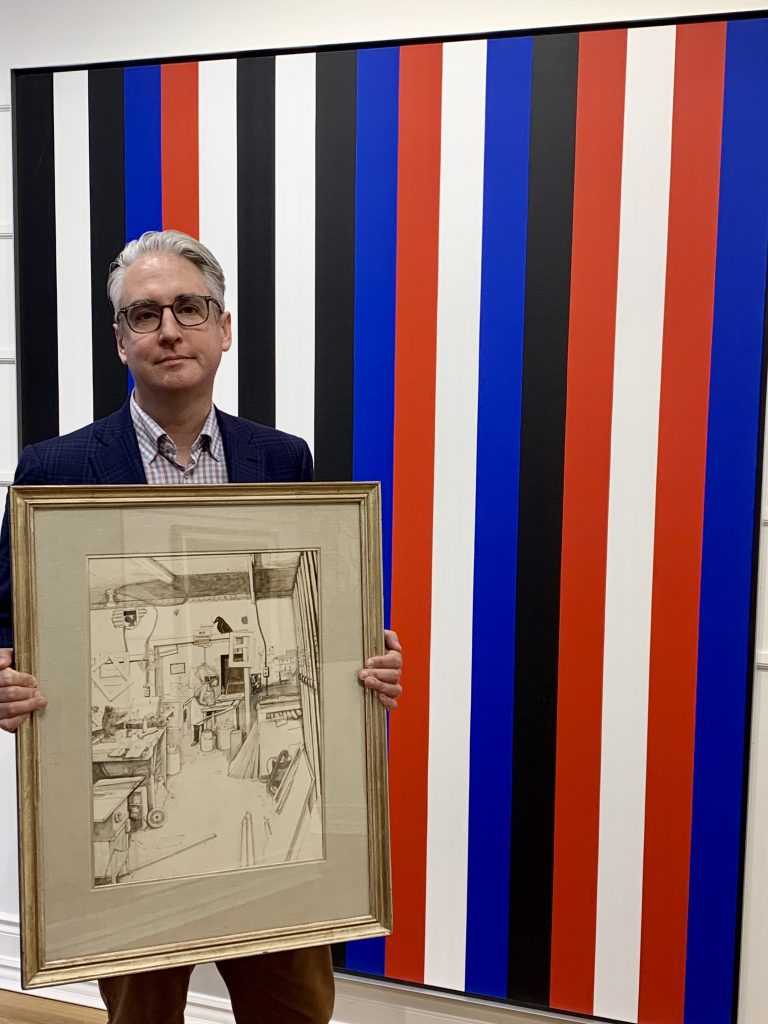
William Kurelek “Brian Dedora in Isaacs Gallery Old Workshop”
Estimated: $30,000-40,000
Spring Live Auction of Important Canadian Art (June 15th)
I have always been captivated by the work of William Kurelek. His representations are often entertaining, sometimes personal and always engaging. A great deal of what I know about William Kurelek as a person has come to me through those who met and knew the artist and Brian Dedora has been generous of his time and recollections with me for almost twenty years. Brian patiently answers my very particular questions about the artist, his life, his practice and his personality, his personal stories providing a perspective that colours the corners of Kurelek’s life that are often not discussed academically.

Estimated: $30,000-40,000
Spring Live Auction of Important Canadian Art (June 15th)
Brian and William Kurelek were more than co-worked at Isaac’s Gallery, they were friends and brothers. When Brian speaks of the artist, he always smiles and/or laughs, sharing the warmth from their close relationship. Brian Dedora in Isaacs Gallery Old Workshop was a gift from William Kurelek to Brian Dedora, the artist refocusing his earlier composition of the shop to have Brian play the central role. Every inch of the drawing provides personal details which Brian and William shared and the drawing not only displays a living memory for Brian, but it also leaves William Kurelek’s vision of his friend from their period together at a historic time and place.
I invite you to read the interview with Brian Dedora which Andrew Kear conducted to accompany the cataloguing for this artwork. The conversation brings to even further life this fantastic and personal work of art.
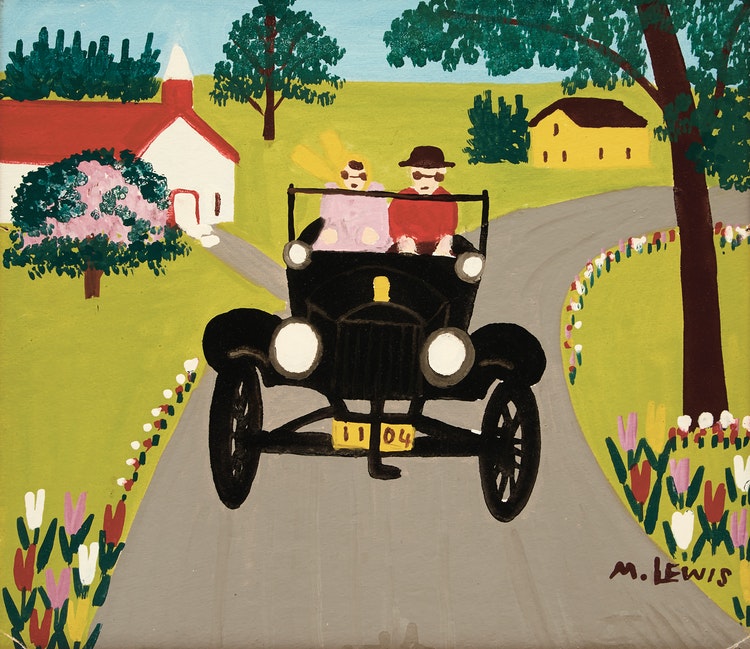
Maud Lewis has captured the hearts of collectors, charmed by her humble upbringing, humour, whimsy, and the sheer joy radiating from her paintings of everyday Maritime life.
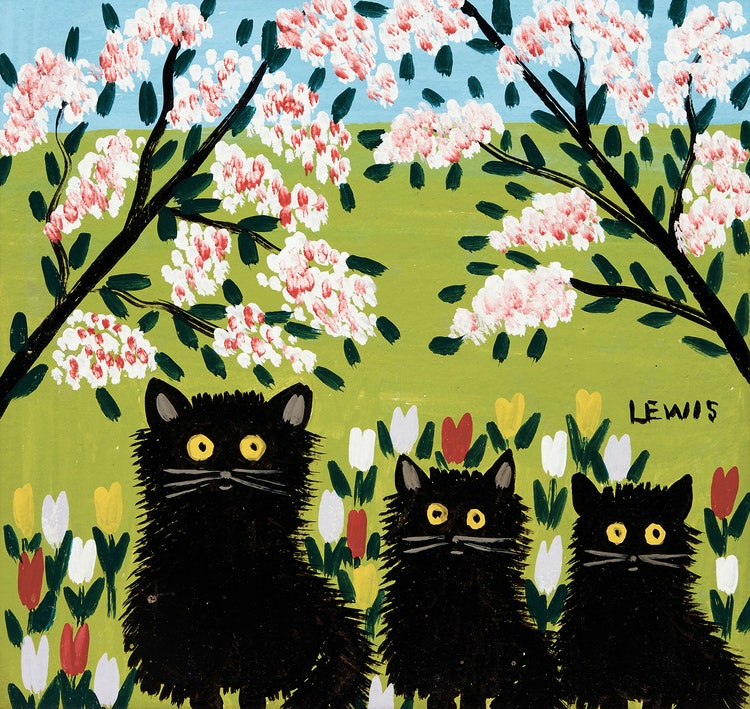
Painting serial images, the inconsistencies of Maud Lewis’ work were undoubtedly intentional. She painted winter scenes with off-season foliage and colours because it pleased her. She repeated her subjects and scenes from memory, and cats and flowers ranked among the artist’s favourite subjects.
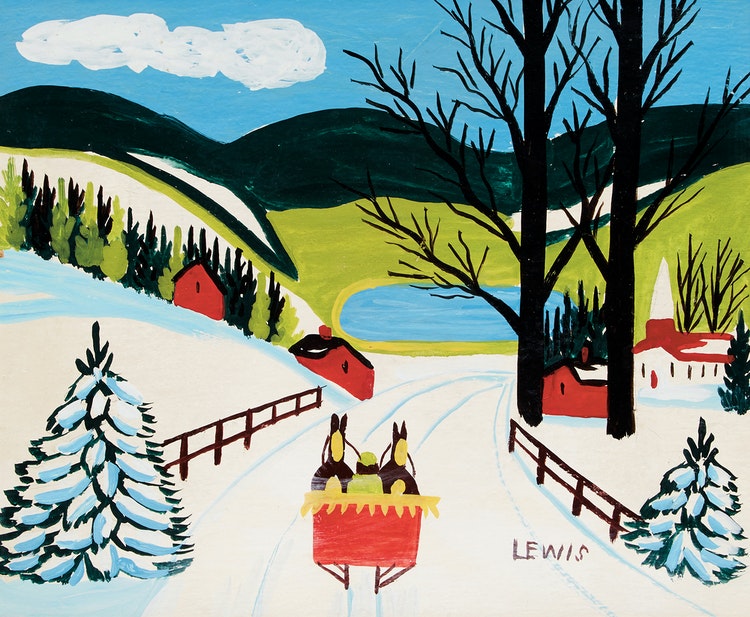
Watch the video below to learn more about Maud Lewis!
It is a delight to handle works by Maud Lewis and we look forward to offering these pieces in our upcoming Spring Live Auction of Important Canadian Art. Learn more about the beloved female artist and the artworks in our major spring auction in the new Cowley Abbott video!
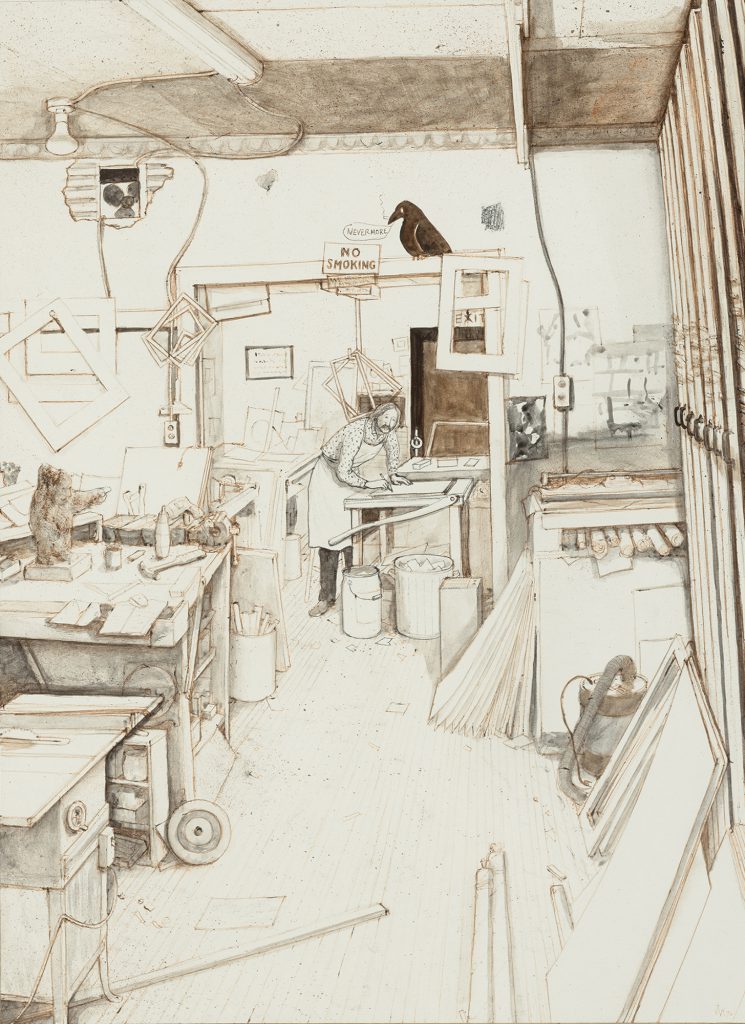
Estimated: $30,000-40,000
Spring Live Auction of Important Canadian Art (June 15th)
William Kurelek was one of Canada’s most idiosyncratic artists of the twentieth century. His work remains both critically acclaimed and popular, although Kurelek resisted ideas of artistic exceptionalism and genius. “The Isaacs Gallery Workshop” is a 1973 ink drawing, once owned by gallerist Avrom Isaacs, that is now in the permanent collection of The Art Gallery of Ontario. In 1976 Kurelek completed “Brian in the Old Workshop”, a cropped version of the Art Gallery of Ontario drawing. It focuses solely on Dedora, bent over cutting glass.Kurelek gifted this drawing to Brian Dedora in 1976 and now Cowley Abbott is honoured to be entrusted with this personal and enlightening artwork.
Take a moment to watch this video narrated by Rob about Kurelek and this personal artwork, “Brian in the Old Workshop”.
Interview with Brian Dedora
In April 2022 Brian Dedora spoke with Andrew Kear about his relationship to William Kurelek, his time at the Isaacs Gallery Workshop, and the drawing “Brian in the Old Workshop”.
AK: You started working at the Isaacs Gallery workshop in 1970. When did you first meet William Kurelek?
BD: I was in Toronto. There was a little gallery on Young Street called the Gutenberg Gallery. And I heard from a Carl Gutenberg, the guy who owned the place, that there was an opening in the framing department at Isaacs. And so, on a Saturday after a beer—I needed some courage—I wandered up to meet Av Isaacs. I said, “I heard that you need a fitter. I am a fitter, and I’m really fast and good.” And he said, “Great, report to the shop Monday morning at nine o’clock.” I was a bit trepidatious, to tell you the truth. You know, being unemployed and feeling a little vulnerable. But when I walked into that shop, within four or five steps into that space, I knew that this was a real live workshop. You could smell it. It was, you know, the lacquers and the shellacs and the gesso and all of it. And then later in the day, Bill [Kurelek] walked in. I didn’t know who he was, actually. He walked down and wanted to know if I was Ukrainian. And I said, “Well, as a matter of fact, my dad is Ukrainian.”
AK: Could you explain what a fitter does, in the context of a framing workshop?
BD: The shop had three distinct spaces, and they were called “ends”— because [workshop foreman] Stan Beecham was British, and this is what they call workshop rooms. So, the first thing you’d walk into was the finishing end. Then you’d walk into a larger room, which was the cutting and joining end. And then the fitting end, where you’d assemble the mats, the glass, the frame and fit it all to the artwork, wrap it all up, put paper on the back with eye screws and wire so that it’s ready to go. I arrived at Isaacs in 1970, just at the Christmas into 1971. So, I was there really from, you know, late-1970 to 1976.
AK: Was Kurelek around the workshop over those six years, between 1970 and 1976?
BD: Yes. He continued to have his own space in the finishing end, and his own bench. That bench is where he, you know, assembled his frames for his paintings. Bill made his end in the shop his own. Every now and then, he’d make up a huge batch of gesso and would paint his benches, drawers, and everything in brilliant white, until it got worn down.
AK: In 1970, what was workshop culture like?
BD: The shop was a place of camaraderie, for and with Bill. And it was a place where he could, you know, meet other men, talk, and stuff like that. But he was pretty straight. The fitter prior to me had hung up some nudies in his end, and Bill came down with a black brush and painted them out. Not their faces, but everything else. We were all essentially run by Stan Beecham, who had an amazing ability to make the workshop flow. Bill often worked at night. There was a little bone of contention between him and Stan because Bill would bring in the barnboards he used for his frames, and there’d be the odd nail that would dull the saw blade. So, Bill decided to bring his own saw blades. It was always pretty magical and warming to come, you know, to the shop on winter days, walking in from the Annex, and see the light on and know that Bill was there. And you’d walk into that lovely warm space, smelling of glue and shellac, and all of it. And there would be Bill, working. And it was our little time to talk. When I graduated from fitting to finishing, I was suddenly working in the same space as Bill. And he was a fantastic teacher.
AK: That is my next question. What did Kurelek teach you, especially in the finishing end?
BD: Well, we had already talked about our rather authoritative Ukrainian fathers. The previous finisher had left, and so I just jumped in the deep end and took over. I knew some basics and stuff, but the finisher prior to me gave me the wrong formulas—so that I couldn’t be as good as him, right? That was what it was like in the old times. Anyway, there was a frame I was finishing, and I couldn’t get the gold leaf into a beading line—the place where two shapes join in a frame. I said, “Bill, I don’t know how to do this.” He came over—he was so quiet, so generous—and he showed me how to bring the gold leaf slowly across so you can bury it into that deep line and then draw it away to do the next part of the frame. It’s a technique I’ve used all my framing life. But he was wonderful. He was very sensitive to somebody deriding you because of your ignorance.
AK: What were your impressions of the frames Kurelek made for his own work?
BD: Bill understood classical framing intimately because of his work in London. And he was able to make little innovations on that. I love his barnboard stuff. In the basement of the shop, he had a whole load of barnboard that he had scavenged from God knows where. Kurelek would paint on his gesso, let it dry. He would rub it down with cold wet linen. And that was the only smoothing that took place. He did not use sandpaper to take out the flaws. And so, when he gilded it, it was a much more organic feeling than the very precise French tradition. Bill’s work was very organic, very rounded. The odd flaw in the gold—they call it a “holiday”—was allowed to stay. And it worked because he knew how to blend the whole thing together.
AK: What is it about Brian in the Old Workshop that resonates with you?
BD: Oh, well it is the spirit of that place. I mean, there’s all sorts of detail, and the place was so full of detail, really. There’s a weight in the picture if you notice—like, for lifting. Well, that’s what we used to weigh things down with in the shop. That’s me in the background there, you know, smashing glass. But there’s so many references, like the little Inuit sculpture on Stan’s bench, pointing at us. But also, the machinery. There’s the press, and then you’re looking into the fitting room. I love that “Nevermore” from Poe’s raven—because it was literally the shop’s fitting end. Right? Bill loved puns. We looked onto the alley, just off Yorkville. And, at that time, it was an older Toronto, so the back lane was old swayback fences and hollyhocks growing there, and the sunlight coming in would hit your workspace in a particular way. And it was warm and toasty in there because we were always heating up something. The shop was much more medieval than what a shop would be today, with nail guns and mat cutters. We were doing everything by hand. It was all by hand. And so, it was a completely different framing world than what you would see if you walked into a shop today.
Join us on June 15th at 7 pm when this William Kurelek drawing will be offered in our major spring auction.

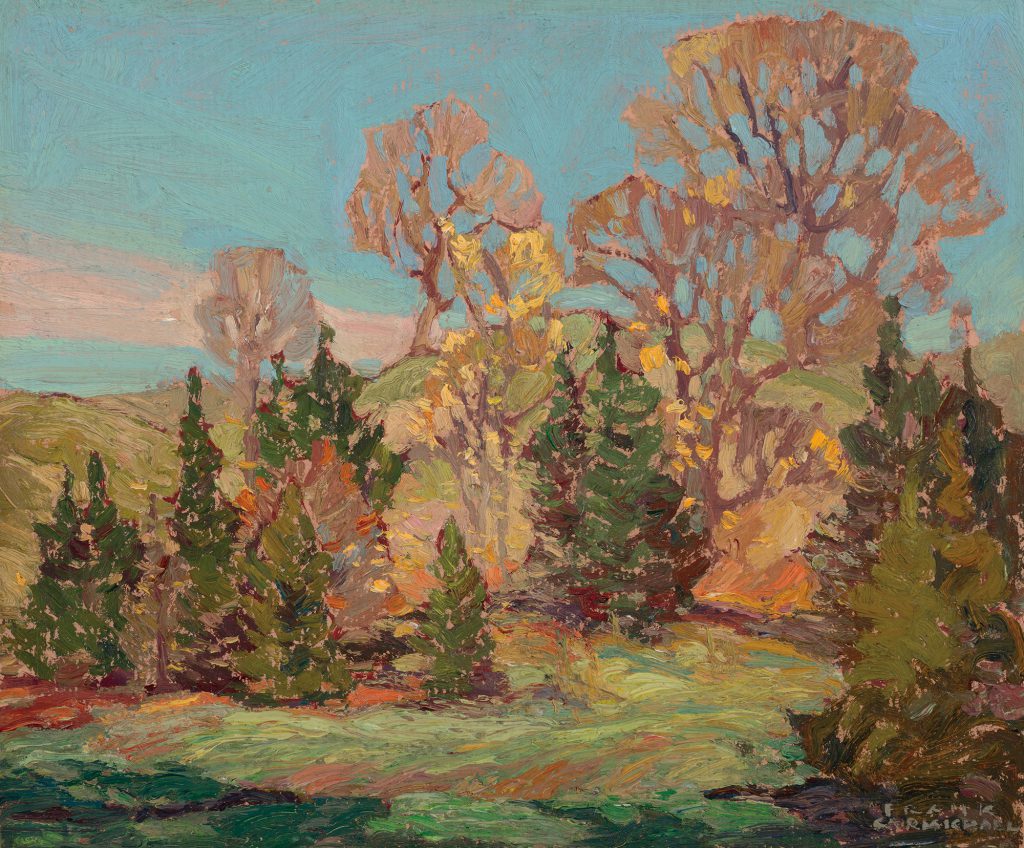
Spring Live Auction of Important Canadian Art (June 15th)
There are many fantastic paintings by Franklin Carmichael included in the permanent collection of the AGO. “Study of Trees, Autumn” by Carmichael relates to these prime period signature works, executed with a pageantry of autumn colours. This Carmichael painting has a wonderful exhibition history and impeccable provenance. Learn more with Peter in this short video.
Take a closer look with Peter!
Our evening auction on June 15th is the first opportunity for collectors to both view and acquire this rare and wonderful work by the artist. Visit https://cowleyabbott.ca/artwork/AW40521!

